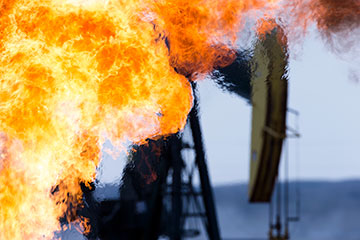
A study uses multisatellite data to detect the largest methane leak recorded in an oil well. [Image: Getty Images]
Methane emissions have been responsible for about 30% of global warming since the start of the Industrial Revolution, but they can be difficult to track, especially when they occur in remote regions of the world. Now, a growing constellation of methane-sensitive satellites are enabling the detection of leaks and blowouts, typically caused during the drilling, completion and production phases of oil and gas wells (for more on optics-enabled methane detection, see “Monitoring Methane to Curb Climate Change,” OPN, July/August 2024).
In a new study, an international group of researchers used this satellite network to track what they say is the largest recorded human-caused methane leak in history (Environ. Sci. Technol. Lett., doi: 10.1021/acs.estlett.4c00399). They combined data from a number of space-based tools, including the Sentinel-5P/TROPOMI global mapping mission and high-spatial-resolution hyperspectral or multispectral imagers.
Characterizing a gas leak
The methane leak, which began on 9 June 2023, stemmed from a well blowout and fire at the remote Karaturun oil field in Kazakhstan. The fire led to a loss of control of the well and a 10-m-high blaze. Days later, a 15-m-wide crater formed as rocks around the well collapsed. The gas flow was not successfully contained until 25 December of that year, after releasing about 131,000 tons of methane into the atmosphere.
Researchers led by the LARS group of the Institute of Water and Environmental Engineering of the Universitat Politècnica de València, Spain, aimed to describe the evolution and magnitude of this leak using data from different types of methane-sensitive satellites. They found that data from TROPOMI and other multispectral satellites, which offer frequent global coverage, were necessary for observing the first few weeks of the leak—when emission rates were highest—before the high-resolution hyperspectral imagers could be tasked over the site.
For the data from the multispectral imagers, the team used specific models and filters to remove interference, such as discontinuities between land and water. Once emission rates fall below their high detection threshold, however, these satellites are no longer able to detect the methane plumes.
They found that data from TROPOMI and other multispectral satellites, which offer frequent global coverage, were necessary for observing the first few weeks of the leak—when emission rates were highest.
Combined data
The data from the high-resolution hyperspectral imagers (GHGSat, PRISMA, EnMAP and EMIT), which have sparse spatiotemporal sampling compared with TROPOMI but a much higher spatial resolution, came into play after TROPOMI’s high detection threshold no longer fit the bill. But they needed refined processing methods that were specific to the large, dense methane plumes found at the Karaturun leak.
The researchers achieved this optimization by applying the logarithmic version of the matched-filter retrieval and removing plume pixels when calculating the necessary statistics, which they say resulted in substantial improvements in plume quantification. Furthermore, spectral radiance and water vapor maps were used to ensure that smoke and water weren’t impacting plume detection. The researchers explain, “These optimized methods include the implementation of a tailored filter to detect plumes and specific methane quantification models for hyperspectral instruments.”
With all of these data combined, the team detected a total of 115 methane plumes over the 205-day leak, showing how incorporating data from different methane-sensitive satellites results in a comprehensive picture of emissions from a sustained gas leak.
“Our work demonstrates how advanced space-based tools are essential for discovering and managing these super-emission events, enabling accurate reconstruction and robust emissions quantification,” say the LARS group members.
